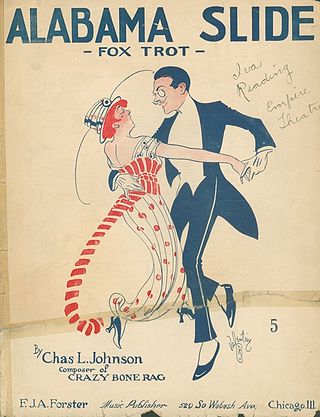Foxtrot is a dance and style of music.
Contents
- Arts, entertainment, and media
- Films
- Music
- Other uses in arts–entertainment–media
- Horses
- Other uses
- See also
Foxtrot or fox trot may also refer to:
Foxtrot is a dance and style of music.
Foxtrot or fox trot may also refer to:
Gateway often refers to:
Action may refer to:

The foxtrot is a smooth, progressive dance characterized by long, continuous flowing movements across the dance floor. It is danced to big band music. The dance is similar in its look to waltz, although the rhythm is in a 4
4 time signature instead of 3
4. Developed in the 1910s, the foxtrot reached its height of popularity in the 1930s and remains practiced today.
Messenger, Messengers, The Messenger or The Messengers may refer to:
Variety may refer to:

Horses can use various gaits during locomotion across solid ground, either naturally or as a result of specialized training by humans.
Extra, Xtra, or The Extra may refer to:
A family is a domestic or social group.
Target may refer to:
Diana most commonly refers to:
Faithful may refer to:
Memory is an organism's ability to store, retain, and recall information.
Feathers are epidermal growths which form an outer covering on birds and some dinosaurs.

An ambling gait or amble is any of several four-beat intermediate horse gaits, all of which are faster than a walk but usually slower than a canter and always slower than a gallop. Horses that amble are sometimes referred to as "gaited", particularly in the United States. Ambling gaits are smoother for a rider than either the two-beat trot or pace and most can be sustained for relatively long periods, making them particularly desirable for trail riding and other tasks where a rider must spend long periods in the saddle. Historically, horses able to amble were highly desired for riding long distances on poor roads. Once roads improved and carriage travel became popular, their use declined in Europe but continued in popularity in the Americas, particularly in areas where plantation agriculture was practiced and the inspection of fields and crops necessitated long daily rides.

Tahiti Trot, Op. 16, is an arrangement for symphony orchestra by Dmitri Shostakovich of the song "Tea for Two" from the musical No, No, Nanette by Vincent Youmans. It was composed in 1927 and resulted from a bet between the composer and the score's dedicatee, Nicolai Malko.
An apple is an edible fruit.

Cross-step waltz is a social ballroom dance in time, performed primarily in closed position, to slower tempo waltz music. It is characterized by a "primary cross-step" where the Lead role crosses the right foot over the left, as the Follow role crosses the left foot over the right, on the first count of the musical measure. Cross-step waltz can travel and rotate like traditional waltzes, while the dynamic of the cross-step facilitates a wide range of traveling variations.
"The Musical Box" is a song by English progressive rock band Genesis, which was originally released on their third studio album Nursery Cryme in 1971. The song is written in the key of F# major. This song is the longest song on the album at ten and a half minutes.
Love Story or A Love Story may refer to:
"Midnight, the Stars and You" is a British-American popular foxtrot song written by Harry M. Woods, Jimmy Campbell and Reg Connelly and published in 1934.